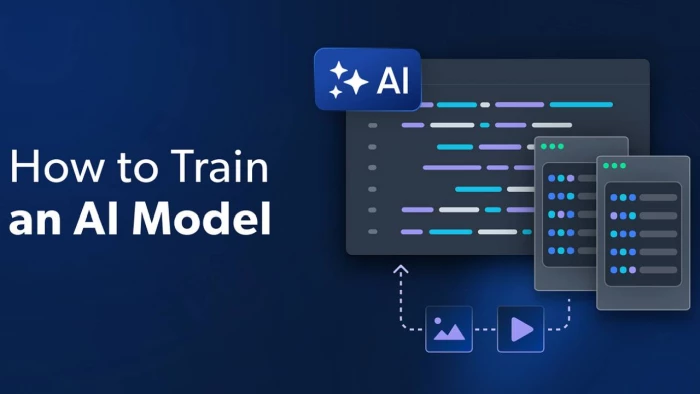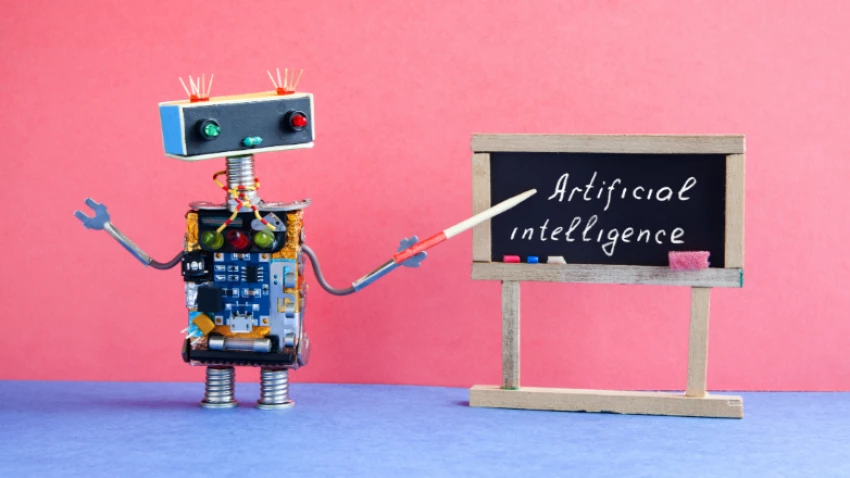

Your social media feed knows you better than your close friends. Netflix recommends the show that is right when you need it. Your email automatically filters out spam in no time and with minimal effort.
Behind every one of these seemingly magical moments is an AI model that someone, somewhere, taught to be incredibly smart.
The good news is that learning how to train an AI model isn’t just for tech experts. While it seems complicated, understanding the basics makes it child’s play. Think of it as teaching a bright student who can quickly learn from millions of examples.
Whether you're a beginner or have some tech skills, this quick guide can help you train an AI model from scratch without a PhD or getting lost in jargon. You could even use these steps to create something fun, like an AI chatbot, or build advanced systems.

Think of developing an AI model as you’d think of educating a child. You provide examples, indicate what is correct and incorrect, make corrections, and then allow the child to practice. For machine learning, you provide data to an algorithm, observe how it predicts or acts, and modify until it improves.
Now, let's go in-depth into the steps of training an AI model:
High-quality data is the foundation of every successful AI project. Because if the foundation isn't sturdy, the entire thing can collapse.
In addition, the quality of your data will impact the performance of your AI model, which is why this step is of the utmost importance.
| Data Collection Method | Description | Typical Users and Applications |
| Web Scraping | Extracting organized data from the internet through automated methods | e-Commerce companies conducting competitor analysis |
| Crowdsourcing | Data collection from a bunch of people via different online platforms | Sentiment analysis done by social media platforms |
| In-House Data Collection | Gathering data from internal systems, surveys, and experiments | Software companies developing proprietary tools |
| Synthetic Data Generation | Using algorithms and simulations to create artificial data | Healthcare organizations are testing AI for diagnosis while protecting sensitive data |
Once you’ve chosen your collection method, clean and prepare it. This includes removing duplicates, filling in missing values, normalizing numbers, encoding categories, and organizing the data so your model can understand it.
This is where things get interesting. Choosing the perfect model architecture is like choosing the right tool for your job. You wouldn't use a hammer for painting; similarly, you won't use a text-processing model for image recognition.
Here are some popular model types:
1. Convolutional Neural Networks (CNNs): Best for visual tasks like image classification and object detection.
2. Transformers: These are used in language tasks and powering tools like ChatGPT and Google Translate.
3. Random Forests: Effective for structured data and various business problems.
4. Recurrent Neural Networks (RNNs): Suitable for sequential data, but transformers are now more common.
Key Point: Choose the model that fits your task—CNNs for images, transformers for text, and random forests for structured data.
Training isn’t a one-size-fits-all approach. Choose the learning style that suits your data situation:
● Unsupervised Learning: This approach is used when you want the model to identify patterns or clusters in unlabeled data.
● Semi-Supervised Learning: This combination of supervised and unsupervised learning is ideal for situations with a small number of labeled examples but a large amount of unlabeled data.
● Self-Supervised Learning: The model learns from the data by creating tasks in this method. Pretraining large language models (LLMs) often relies heavily on this approach.
● Reinforcement Learning with Human Feedback (RLHF): In this method, humans rank the outputs, enabling the model to learn preferred responses. This technique is widely used in many modern LLMs, including ChatGPT, and AI chatbot development.
Before training, divide your data into two parts: a training set (usually 70-80%) for learning patterns and a test set (20-30%) to test the model’s performance.
A generative AI development services company often automates this process when building production-ready solutions.
Different models need different training methods. The model learns from example data labeled with correct answers in supervised learning. In unsupervised learning, the model looks for patterns in data that do not provide answers.
With reinforcement learning, the model improves by experimenting and adjusting its behavior. It receives rewards for good actions and penalties for mistakes. Deep learning models, like neural networks, use algorithms such as backpropagation to change their settings and reduce prediction errors.
Now it's time to test your model with the data you saved earlier. This is its final exam with new data it hasn't seen before.
Apply your model to the test data and examine the evaluation metrics:
- Accuracy: How often is it correct?
- Precision: It measures how often the model is right when it predicts ‘yes.’
- Recall: How many actual "yes" cases did it find?
- F1 Score: A combination of precision and recall.
If your model does well, great job! You've trained an AI model. If not, you'll need to troubleshoot and improve it.
Good-quality data is essential. Make sure your data is diverse and accurate from the beginning.
Carefully handle sensitive data and personal information. Ensure it's anonymous, as this helps you obey data protection laws.
Training large models requires significant computing power, like multiple GPUs and memory. Cloud services can provide the resources you need.
Complex models can be “black boxes.” For applications like healthcare or finance, explaining why a model made a specific prediction is crucial.
A trained model is never perfect. Over time, data changes, and new patterns emerge. Make monitoring and retraining part of the routine.
Once you've mastered the basics, here are some pro techniques:
Not enough training data? Just generate more! You can rotate, flip, or crop images and adjust brightness. For text, rephrase or use synonyms. This helps your model recognize a cat in different positions, whether sitting or upside down.
Instead of picking random data to label, let your model identify which examples are most helpful to learn from. It’s like a student asking to focus on a topic they find confusing.
Train several models and let them vote on the best answer. Since each model notices unique patterns, combining them often produces better results.
Large models require powerful computers. To save on hardware costs, use GPUs and consider cloud services like AWS, Google Cloud, or Azure.
Training good models takes time, sometimes days or weeks. Be patient and expect some trial and error.
Use data responsibly and legally. Watch for biases that may result in unfair outcomes.
The field is evolving rapidly. Techniques like self-supervised learning are reducing the need for labeled data. With few-shot learning, models learn effectively even when given very few samples. On the other hand, federated learning allows models to be trained across distributed datasets without compromising privacy.
Training an AI model might initially seem intimidating, but everyone has to start at one point. Begin with simple projects, like an AI chatbot, and gradually move towards bigger challenges.
AI is an exciting field, with new techniques, better resources, and supportive communities ready to help you. Whether you’re working on advanced healthcare tools or fun chatbot assistants, the steps to train an AI model remain the same.
Training an AI model doesn’t require advanced degrees; it requires curiosity, practice, and persistence. Start small, like building an AI chatbot, and move toward bigger projects as your confidence grows.
The future is bright, and with persistence (and the help of a generative AI development services company), you can build something amazing.
Be the first to post comment!